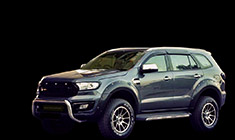News
Land Rover Defender 90: Ownership Experience
For the greater part of my life, I have been chasing the dream of owning a Land Rover Defender. It was supposed to remain a dream forever. But suddenly now that it has been fulfilled, I don't know what to do!
BHPian BlackPearl recently shared this with other enthusiasts.
The only dialogue that came to my mind is that of The Joker - “I’m a dog chasing cars, I wouldn’t know what to do with one if I caught it. You know, I just do… things.”
For the greater part of my life, I have been chasing the dream of owning a Land Rover Defender. It was supposed to remain a dream forever. But suddenly now that it has been fulfilled, I don't know what to do!
It has been a bit over four months since we got the Defender and I have now been able to gather my senses. The next step is to write an ownership log on Team-BHP. But before that, a couple of pictures of our beauty, the Land Rover Defender 90 XS in Corris Grey.


Defender Pros
- Stunning retro looks and road presence. Sorry, not retro "looks", it is ancient!
- Huge ground clearance for off-roading. Well designed underbody with important things well protected
- Mechanically simple, less things to go wrong
- Unlimited potential for modifications, money is the only limit. Huge amount of aftermarket parts are available starting from chassis to interior trims.
Defender Cons
- Cramped interiors, not the most ergonomic vehicle
- Bumpy ride and vague steering
- Difficult to maintain motorway speeds, especially in Europe
- Huge turning radius, it is worse than a truck
This is what Jeremy Clarkson had said about the old Defender:
The last Defender was launched just after the Second World War, then not really altered at all for 67 years.
And when the company did pull the plug, lots of Brexit-type people rushed about saying they would put it back into production themselves, so that proper British men — men, d’you hear — could continue to drive a car that smelt of damp dogs and was full of sharp edges.
A walkaround video of the Defender.
A bit of history of the Defender. Source.

Image Source: Land Rover Defender Brochure year 2013
Land Rover Defender L316
The Defender began life as the Land Rover One Ten (110) in 1983 and swiftly evolved into the Land Rover Ninety (90) a year later in 1984. These replaced the earlier Land Rover Series I, II and III vehicles, and were the only other Land Rover models in production at the time, alongside the Range Rover.
Land Rover 110 & Land Rover 90
The Land Rover 110 started production in 1983. Its name, which was also referred to as the Land Rover One Ten in advertising and handbooks, reflected the 110” wheelbase it was composed of. Only a year after the 110 started production, the Land Rover 90 also entered production. This featured a 93” wheelbase, from which it took its name.
These vehicles were like the Series III Land Rover they replaced; however, they did feature a few key differences. These included a full-length bonnet, newly designed grill, and wheel arch extensions.
Both the engine and several body panels were carried over from the Series III, however both the 90 and 110 were treated to several mechanical modernisations. These included the addition of coil springs, a permanent four-wheel drive system with two-speed transfer gearbox, a modernised interior, and a one-piece windscreen. One of the Land Rover 110 models was initially built with a part-time 4WD system. However, this was dropped the following year due to low sales.
The Land Rover 90, launched in 1984, featured even more modernisations and upgrades. From the permanent addition of wind up windows (a departure from the sliding panels previously) to the introduction of a 2.5 L diesel engine with a modern fuel-injection system and four-speed transmission. These models also made the switch from leaf spring to coil spring suspension, which improved off-road driving and ride comfort.
Becoming The Defender
Following the introduction of the Discovery model in 1989, the 90 and 110 models underwent a name-change to become the Land Rover Defender.
The change saw the Defender receive a new 200Tdi engine, which allowed the vehicle to cruise more comfortably at high speeds and tow heavy loads on hills while remaining economical.
The 127 also changed name, becoming the Land Rover Defender 130. While the 127” wheelbase remained the same, the composition of the vehicle changed and instead was made from scratch. In this respect the Defender 130 was terribly similar in basic structure to both the 90 and 110 apart from its longer wheelbase.
In 1994 a new engine was introduced, the 300Tdi, which was fitted in both Defender and Discovery vehicles. In South Africa, a unique Defender was available between 1997 and 2001 with a BMW M52 engine as well as the normal TDi engine.
Evolution of The Land Rover Defender
As with any other vehicle, the Defender evolved over time. In 1998, a new 2.5L turbodiesel engine was introduced called the TD5. The driving force behind this was the upcoming changes to the Euro III emissions regulations. Further refinements were made to this engine in the 2002 model year for the same reasons, as emission regulations were set to become even tighter.
Several trim levels were also introduced throughout the years. In 2002 the XS 4×4 made its debut. Marketed as a luxury vehicle, features included a heated windscreen, heated seats, air conditioning, ABS and part-leather seats. Some tweaks were also made to the dash centre console, and front electric windows were made available for the first time in the Defender series.
2007 Year Model Updates
Further changes were made to the Defender in the 2007-year model. The Td5 engine was replaced with a 2.4L Ford Duratorq engine mated with a six-speed gearbox.
Other changes were also made to the interior. The old dashboard layout was stripped out and replaced with a full-width fascia. New instruments were also introduced from the Discovery 3 and a new heater and ventilation system were also installed.
In response to a change in EU legislation, the four inward-facing seats of the Defender were stripped out and replaced with 2 forward-facing seats. This reduced the Defender 90 to a four-seater vehicle and the Defender 100 4×4 to a seven-seater.
Some minor changes were also made to the exterior. The bonnet was reshaped to allow for the new engine. Air vent flaps that previously featured on the windscreen were also removed and the passenger and rear loading doors were also re-engineered.
2012 Year Model Updates
Upcoming changes to safety regulations meant a wholesale redesign of the Defender was soon to be on the horizon. For 2012 models, this meant a new 2.2 L ZSD-422 engine with the same six-speed gearbox. This engine also featured a diesel particulate filter.
The only other change to this year model was the reintroduction of the soft top body style, which was bought back to the general market following customer feedback.
Limited & Special Edition Vehicles
Throughout its production, the Defender has enjoyed a number of limited and special edition runs. These include:
- Land Rover 90SV (1992)
- Limited Edition (LE) (1997)
- Defender 50th (1998)
- Heritage (1998)
- X-Tech (1999)
- Tomb Raider (2000)
- G4 Edition (2003)
- Defender Black (2002)
- Defender Silver (2002)
- Defender SVX (2008)
- Bespoke Paul Smith Defender (2018)
- Defender Works V8 70th Anniversary Edition (2018)
Several special edition Defenders have also been released overseas for specific markets. These include:
- Sahara
- 55th Anniversary Defender 90
- Braemar
More details about the evolution from Series I to Defender can be found in this link.

Continue reading BlackPearl's review & experience for more insights, information and BHPian comments.



















